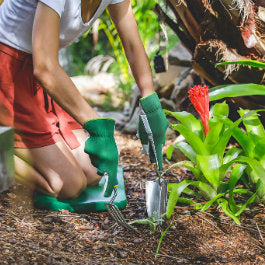
Whilst you spend time and effort tending to your plants and working hard to keep them thriving, weeds pop up, survive harsh conditions and return month after month without a second thought. No wonder gardeners find them so frustrating! These unwanted plants are quick to reproduce, and once established they are great survivors, appearing in lawns, flower beds, amongst the veggies and in between pavers, filling any empty space they can lay their roots in.
Unfortunately, there is no miracle cure to banish weeds for good, but there are steps you can take to win the war on weeds without the need for chemicals, and, with a bit of groundwork, prevent them from taking hold in the future.
Step 1 - Identify the problem

Whilst some weeds such as thistle, oxalis and dandelion are easy to recognise, there are many that aren't as simple to spot. Some weeds boast beautiful flowers that can make them hard to identify as a problem plant, especially for novice gardeners, so it’s a good idea to identify what you have intentionally planted first, and anything else that pops up should be questioned – though not necessarily removed. Some plants will grow through pollination and will make an attractive addition to your flower bed, and some could be beneficial to pollinators and other helpful insects such as ladybirds and spiders that can assist with natural pest control. If the plant grows vigorously, has spread or you see it in more than one patch, then it’s very likely a weed and should be pulled up as soon as possible.
Generally speaking, there are two categories of weed: annual and perennial. Annual weeds are much easier to pull up than their stubborn counterparts. With thicker, more extensive roots, perennial weeds can be tricky to pull out in one go as often their roots break, allowing a new plant to form beneath the soil.
Step 2 - Mind the gap

If there’s empty space for them to grow in, weeds will waste no time in invading the soil. One way to help fend them off is to fill in any gaps. A dense planting plan that covers almost every inch of the soil with foliage is a good start. If sunlight can’t reach the earth below, then the conditions will likely become too tough for weeds to establish in.
Covering beds, borders and bare areas with a thick layer of mulch has proven to be the most successful method in eliminating weeds, providing the soil is completely free of weeds before you start. Intensive mulching with materials such as polythene or cardboard will help eradicate the problem slightly quicker than using a thick layer of compost, which could have weed roots inside. You can also use this method if you intend to smother weeds in empty beds.
Step 3 - Turf war

If you have a patchy lawn then it’s important to fill gaps with new seed or turf as soon as possible before weeds have the chance to take over, potentially killing more of the lawn. Mowing the lawn regularly and spraying with the correct fertiliser twice per year will help encourage denser growth. If you do spot weeds growing amongst the grass, pull them up straight away before they have the opportunity to seed and spread.
Step 4 - Eliminate the issue

Weeds can appear at any time, and though there are a range of herbicides and weed killer chemicals on the market, the best and safest way to get rid of weeds is to physically pull them up – roots and all. This is a tedious task, however with tools such as Hoselink’s weeder, or a hoe, this can be made a little less painful.
It’s best to leave your weeding until after a rain shower, as it will be much easier to pull roots up from moist soil. Try and get your hand firmly underneath the weed’s foliage, pinching close to the base of the stem, then use a weeder, trowel or fork to dig into the soil and lift the roots up so that the entire plant is removed. Tearing up the intruders isn’t just a one-time job, it can take weeks of pulling out weeds before you’re truly weed-free. But, commit to a regular weekly routine of weed-pulling and you’ll prevent weeds from seeding in the first place, making the end result well worth it.
If you keep animals such as chooks, then put them to work feasting on the offending areas, remembering to protect any plants you do want to keep first, as chickens aren’t fussy! Often chook-keepers let birds run loose in the veggie patch at the end of the season, where they can reign free pecking at weed seeds whilst simultaneously fertilising the soil.
Step 5 - Waste not, want not

You may be surprised to hear that weeds are actually good for the compost heap. However, annual and perennial weeds need to be treated differently. Annuals can only be added before they go to seed, when they can be buried inside a hot compost heap. Perennials require a little more to kill them. A truly hot heap that gets above 50°C will work, or alternatively rot them in water if you only have a cold compost heap. Sink the weeds into a bucket of water and weigh them down so the roots stay beneath the surface. Leave the bucket, covered, for a few weeks before adding the drowned weeds to your compost pile. The liquid can be strained and used as a great natural fertiliser: dilute one part weed liquid to five parts fresh water.











